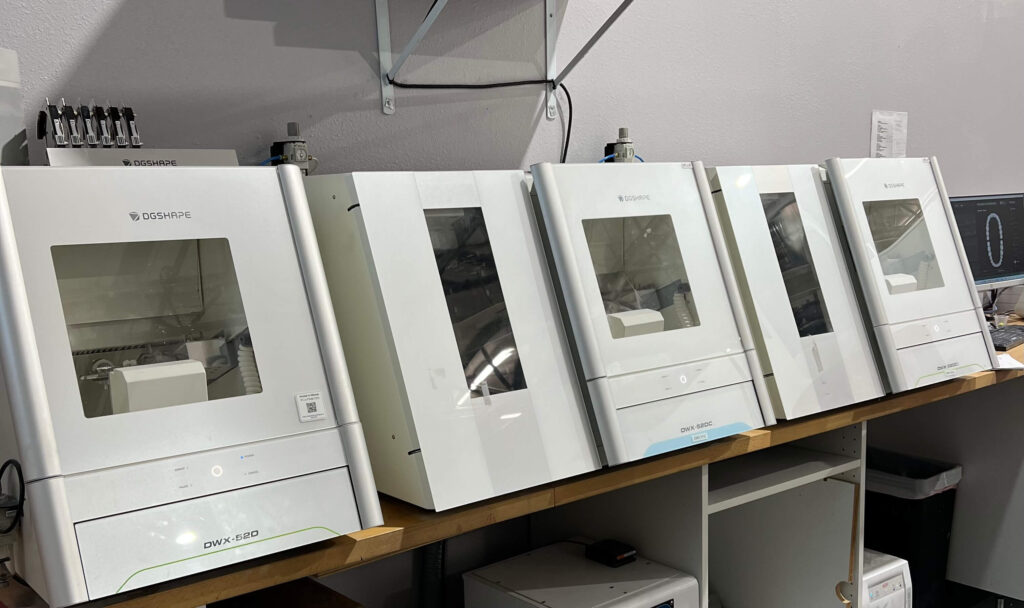Digital dentistry has revolutionized the way dental procedures are performed, and for good reason. At Element Dental Lab, we’ve recently seen a huge shift from analog to digital. Five years ago, IO scanners were rare, now they’re in nearly every practice. There are several reasons why digital dentistry workflows are superior to analog processes:
- Increased accuracy: Digital dentistry workflows, such as digital impression taking, allow for increased accuracy compared to analog processes. This leads to a more precise and comfortable treatment experience for patients and improved outcomes.
- Improved efficiency: Digital workflows streamline the treatment process, reducing the time and effort required to complete a procedure. This not only improves patient experience but also increases productivity and profitability for dental practices.
- Enhanced collaboration: Digital dentistry workflows facilitate collaboration between dental professionals, enabling them to work together to provide the best possible patient care.
- Increased patient engagement: Digital workflows allow for increased patient engagement and education. Patients can easily view and understand their treatment plans and progress, which can lead to higher levels of patient satisfaction and improved treatment outcomes.
- Better data management: Digital dentistry workflows allow for easy and efficient data management, reducing the risk of data loss or inaccuracies. This leads to a more organized and effective practice.
- Reduced waste: Digital dentistry workflows reduce waste compared to analog processes, as digital tools and technologies allow for precise and accurate treatment planning and execution.
- Improved patient safety: Digital dentistry workflows can improve patient safety by reducing the risk of errors and complications. Digital tools and technologies can also assist in early diagnosis and treatment planning, leading to better outcomes for patients.
Digital dentistry workflows offer several advantages over analog processes, including increased accuracy, efficiency, and patient engagement, better data management, reduced waste, and improved patient safety. By incorporating digital workflows into their practice, dental professionals can provide their patients with the best possible care and outcomes.
So now that we can see why you should invest in digital dental technologies, where should you start? For completeness, I’m going to include some items that probably most offices have and take for granted, but since I’ve been around for a while, I literally saw each of these transform the way that I practice:
The digital technologies that a dental office should invest in first depend on their specific needs and budget, but some widely adopted and useful technologies include:
- Digital radiography (digital X-rays): There are so many advantages to digital x-rays. At this point, the easiest sell to a dentist is an argument of economics. With the cost of a reusable digital sensor and software drastically reduced from what it was, it is less expensive to use digital x-ray technology than pay for film and chemicals to keep processors running. However, I think the biggest value add is in the patient experience and education, which translates to increased treatment acceptance. Additionally, digital x-rays require lower dosage than film which is safer for patients and your dental team members. Using filters and other tools also improve the diagnostic qualities of digital over film and allow the dentist to find issues earlier for more conservative treatment. If this wasn’t enough, the environmental impact of not using traditional processing chemicals and lead film packaging are significant. As another discussion, a cone beam computed tomography (CBCT) machine in the office makes a lot of sense for most practices, but we’ll leave that for another time.
- Dental practice management software: This can help manage patient records, appointments, billing, and other administrative tasks, but is also a huge time saver for the dentist. If you hate writing treatment notes as much as I do, but feel hamstrung due to its importance, auto-notes can change the way you practice. I recommend Open Dental for its relative value and highly customizable interface. What it lacks in flashy graphics it more than makes up for in versatility and utility.
- Intraoral cameras: A picture is worth a thousand words. Especially if you are a younger dentist, or a new practice owner, or even a long time practice owner with an influx of new patients, IO cameras are indispensable. Not only do they explain way better visually than you can with words, the picture creates an immediate understanding of the situation and establishes trust. Just show them the picture, point out the cavity, fracture, etc., then shut up. Wait for the patient to ask “Well, what do we need to do about that?!”
- Intraoral scanner systems: While an IO scanner will definitely be a learning curve, it will literally change the way you practice dentistry for the better. As a tip from experience, keep your PVS and triple trays around to bail you out on a busy day while you and your team are learning the technology and software. Once your team is trained, they’ll reach for the digital tech every time and the patients will appreciate the “no goop” experience. At Element Dental Lab, we are well versed in most major scanners, and happy to give you our take on which ones might make sense for you in your practice. Give us a call at 503-616-9301 or email us at elementdentallab.com if you want to talk through the options with us.
- 3D printing: This technology can be used to produce models, guides, and even provisional restorations, making treatment planning and delivery more efficient and accurate. We use 3D printers every day in the lab, and some of our clients are starting to bring the tech in house. Depending on what your practice is doing clinically, this can make sense or not. For example, our clients that do a lot of full arch have found value in printing their temporaries in house while outsourcing the design and milled finals to us at a great ROI. Conversely, if you’re only using it to print models or occlusal guards, it will likely be obsolete before you’ve paid it off. Again, speaking from experience…Feel free to give us a call at 503-616-9301 or email us at elementdentallab.com if you want us to talk through your specific situation. Another factor here is having a detail oriented team member who will “own” this process and the nuances of 3D printing. Conversely, you can manage it yourself as the dentist, but usually this doesn’t make any financial sense trading your productive time for 3D printing tasks. So unless you find it to be a fun hobby, we wouldn’t recommend it.
I hope this post was helpful to you as you navigate the rapidly changing digital technologies in your practice. It can be overwhelming, but it’s an amazing time to be practicing dentistry!

